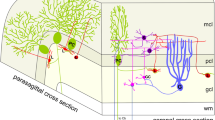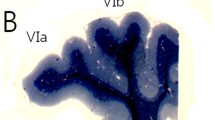Abstract
The immunointensities of calcium-binding proteins parvalbumin (PV) and calbindin D28K were quantified in different parts of Purkinje cells and interneurons (basket cells and stellate cells) of the rat cerebellum. An electron microscopic, postembedding immunogold procedure on Lowicryl K4M-embedded thin sections was applied. Neuronal profiles were identified by double-labeling immunocytochemistry using the combination of the two primary antibodies, mouse monoclonal anti-rat calbindin D28K and rabbit polyclonal anti-rat PV. The secondary antibodies were conjugated with colloidal gold of different sizes (10 and 15 nm diameter). In the cerebellar cortex, double-labeled profiles were identified as Purkinje cells and profiles labeled only with anti-PV were identified as inteneurons. The densities of gold particles were used for statistical comparison of the relative levels of PV and calbindin D28K in somata, dendrites, dendritic spines, axons and axon terminals of Purkinje cells, and interneurons. The axons and axon terminals of Purkinje cells and basket cells had significantly higher levels of PV immunoreactivity than Purkinje cell somata, primary, secondary, and tertiary dendrites, and dendritic spines, as well as interneuron somata. On the other hand, the present study could not determine conclusively whether calbindin D28K was distributed homogeneously throughout soma, dendrites, and axons of Purkinje cells or was also concentrated in Purkinje cell axons. To estimate absolute PV concentrations, we made a series of artificial standard samples which were aldehyde-fixed 10% bovine serum albumin containing given concentrations of PV (0, 12.5, 25, 50, 100, 200, and 400 μM, 1 and 2 mM), and calibration curves were deduced from quantitative immunogold analyses of these standard samples. We also analyzed a fast twitch muscle, the superficial part of the gastrocnemius muscle (GCM), whose PV content was previously reported in a biochemical study; the comparison between gold particle densities of GCM and standard samples indicated that these artificial standard samples could be used to estimate the approximate intracellular concentrations of PV. Based on these analyses PV concentrations were estimated as 50-100 μM in Purkinje cell somata and dendrites as well as interneuron somata, and as 1 mM or more in axons and axon terminals of Purkinje cells and basket cells.
Similar content being viewed by others
References
Baimbridge KG, Miller JJ (1982) Immunohistochemical localization of calcium-binding protein in the cerebellum, hippocampal formation and olfactory bulb of the rat. Brain Res 245:223–229
Celio MR (1986) GABA neurons contain the calcium binding protein parvalbumin. Science 232:995–997
Celio MR (1990) Calbindin D-28k and parvalbumin in the rat nervous system. Neuroscience 35:375–475
Celio MR, Heizmann CW (1981) Calcium-binding protein parvalbumin as a neuronal marker. Nature 293:300–302
Garcia-Segura LM, Baetens D, Roth J, Norman AW, Orci L (1984) Immunohistochemical mapping of calcium-binding protein immunoreactivity in the rat central nervous system. Brain Res 296:75–86
Heizmann CW, Hunziker W (1991) Intracellular calcium-binding proteins: more sites than insights. Trends Biochem Sci 16:98–103
Heizman CW, Berchtold MW, Rowlerson AM (1982) Correlation of parvalbumin with relaxation speed in mammalian muscles. Proc Natl Acad Sci USA 79:7243–7247
Jande SS, Maler L, Lawson DEM (1981) Immunohistochemical mapping of vitamin D-dependent calcium-binding protein in brain. Nature 294:765–767
Kägi U, Berchtold MW, Heizmann CW (1987) Ca2+-binding parvalbumin in the rat testis: characterization, localization, and expression during development. J Biol Chem 262:7314–7320
Kawaguchi Y, Katsumaru H, Kosaka T, Heizmann CW, Hama K (1987) Fast spiking cells in rat hippocampus (CA1 region) contain the calcium-binding protein parvalbumin. Brain Res 416:369–374
Kosaka T, Nagatsu I, Wu J-Y, Hama K (1986) Use of high concentrations of glutaraldehyde for immunocytochemistry of transmitter-synthesizing enzymes in the central nervous system. Neuroscience 18:975–990
Miles R (1990) Variation in strength of synapses in the CA3 region of guinea-pig hippocampus in vitro. J Physiol (Lond) 431:397–418
Miles R, Wong RKS (1984) Unitary inhibitory synaptic potentials in the guinea-pig hippocampus in vitro. J Physiol (Lond) 373:659–676
Millar DA, Williams ED (1982) A step-wedge standard for the quantification of immunoperoxidase techniques. Histochem J 14:609–620
Pinol MR, Kägi U, Heizmann CW, Vogel B, Séquier J-M, Haas W, Hunziker W (1990) Poly- and monoclonal antibodies against recombinant rat brain calbindin D-28K were produced to map its selective distribution in the central nervous system. J Neurochem 54:1827–1833
Storm-Mathisen J, Otterson OP (1990) Immunocytochemistry of glutamate at the synaptic level. J Histochem Cytochem 38:1733–1743
Valentino KL, Crumrine DA, Reichardt LF (1985) Lowicryl K4M embedding of brain tissue for immunogold electron microscopy J Histochem Cytochem 33:969–973
Author information
Authors and Affiliations
Rights and permissions
About this article
Cite this article
Kosaka, T., Kosaka, K., Nakayama, T. et al. Axons and axon terminals of cerebellar Purkinje cells and basket cells have higher levels of parvalbumin immunoreactivity than somata and dendrites: quantitative analysis by immunogold labeling. Exp Brain Res 93, 483–491 (1993). https://doi.org/10.1007/BF00229363
Received:
Accepted:
Issue Date:
DOI: https://doi.org/10.1007/BF00229363




